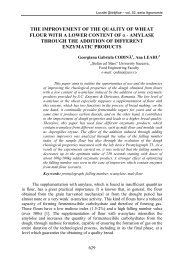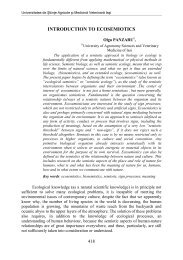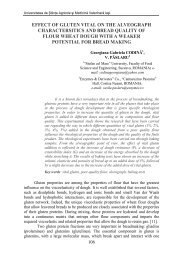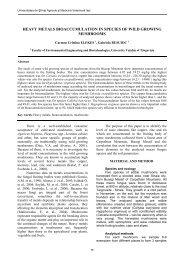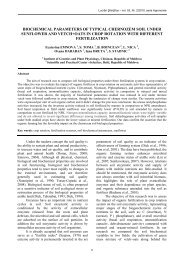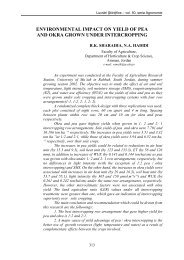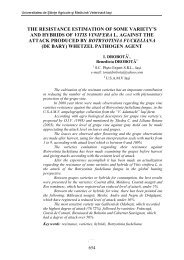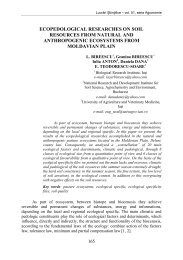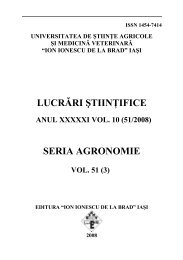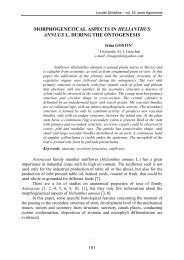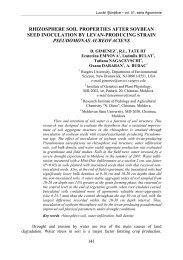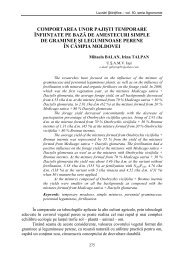conformity and contradiction concerning moral education in family ...
conformity and contradiction concerning moral education in family ...
conformity and contradiction concerning moral education in family ...
Create successful ePaper yourself
Turn your PDF publications into a flip-book with our unique Google optimized e-Paper software.
Lucrări Şti<strong>in</strong>ţifice – vol. 52, seria Agronomie<br />
CONFORMITY AND CONTRADICTION CONCERNING<br />
MORAL EDUCATION IN FAMILY AND IN SCHOOL<br />
V. IOSIFESCU 1<br />
1<br />
București University, D.P.I.P.P. Buzău<br />
e-mail: viosifescu@yahoo.com<br />
School <strong>and</strong> <strong>family</strong> are the most important environments <strong>in</strong> terms of<br />
awareness tra<strong>in</strong><strong>in</strong>g <strong>and</strong> <strong>in</strong>dividual <strong>moral</strong> behavior. The <strong>in</strong>fluences of the two<br />
factors should overlap only under the circumstances of respect<strong>in</strong>g the<br />
pr<strong>in</strong>ciple of full accordance of approaches. When they are not uniform, the<br />
student is fac<strong>in</strong>g an ambiguous situation, <strong>and</strong> his responses are dom<strong>in</strong>ated by<br />
confusion. This way he will be forced to perform a double role – one <strong>in</strong><br />
school <strong>and</strong> the other one at home. This means a dual personality, us<strong>in</strong>g the<br />
strategy of duplicity (simulation, dissimulation), as an efficient way of<br />
adjust<strong>in</strong>g, with serious, long term effects on build<strong>in</strong>g the students’ character.<br />
Key words: character, attitude, compliance / conflict, duplicity<br />
In a society be<strong>in</strong>g for some years <strong>in</strong> a cont<strong>in</strong>uous <strong>and</strong> serious <strong>moral</strong><br />
<strong>in</strong>volution, the construction of <strong>in</strong>dividual <strong>moral</strong>ity becomes crucial for any<br />
<strong>education</strong>al endeavor. Because <strong>moral</strong>ity is expresses <strong>in</strong> all human forms of social,<br />
political, economic <strong>and</strong> professional actions. Actually, the <strong>in</strong>dividual has always to<br />
choose, no matter what he does, between good <strong>and</strong> evil, between a <strong>moral</strong> value <strong>and</strong><br />
its opponent.<br />
In all <strong>education</strong>al environments which have <strong>moral</strong> <strong>in</strong>fluences on the<br />
<strong>in</strong>dividual, <strong>family</strong> <strong>and</strong> school emerge their relevance at least <strong>concern<strong>in</strong>g</strong> the depth<br />
of the effects they produce. Because the explicit <strong>and</strong> implicit objective of school<br />
<strong>and</strong> <strong>family</strong> concerns build<strong>in</strong>g a harmonious personality accord<strong>in</strong>g to social <strong>moral</strong>ity<br />
<strong>and</strong> unitarian <strong>moral</strong> behavior <strong>and</strong> conscience, the activities of the two <strong>education</strong>al<br />
factors should <strong>in</strong>tersect only <strong>in</strong> terms of the pr<strong>in</strong>ciple of unity, of full accordance of<br />
actions. We shall further analyze whether school <strong>and</strong> <strong>family</strong> always act uniformly<br />
<strong>in</strong> <strong>moral</strong> <strong>education</strong> of the child-student., accord<strong>in</strong>g to their effects.<br />
1. Moral <strong>education</strong> with<strong>in</strong> <strong>family</strong>.<br />
In <strong>family</strong>, <strong>moral</strong> <strong>education</strong> is an <strong>in</strong>ductive one, at the level of common sense,<br />
most times. Gradually <strong>in</strong>troduced (as participant) <strong>in</strong> a variety of circumstances with<br />
<strong>moral</strong> significance, the child builds up his own experience step by step, which is<br />
sometimes decisive for the <strong>moral</strong> evolution. Behavior models, the examples given<br />
by <strong>family</strong> will build up <strong>moral</strong>ity. The important th<strong>in</strong>gs here are not the stages of the<br />
child’s <strong>moral</strong> development, but <strong>family</strong>’s approach, the values, examples <strong>and</strong><br />
models that it offers.<br />
The reference po<strong>in</strong>ts of values of <strong>moral</strong> <strong>education</strong> <strong>in</strong> <strong>family</strong>, <strong>and</strong> <strong>in</strong> school<br />
can be found <strong>in</strong> the board of social values, except that, <strong>in</strong> our op<strong>in</strong>ion, the <strong>family</strong>,<br />
as the most conservative <strong>in</strong>stitution, copies its own values. In other words,<br />
449<br />
449
Universitatea de Şti<strong>in</strong>ţe Agricole şi Medic<strong>in</strong>ă Veter<strong>in</strong>ară Iaşi<br />
traditional values are largely circulated <strong>in</strong> <strong>family</strong>, especially <strong>in</strong> the conservative<br />
families, with a lower level of permeability to social <strong>in</strong>fluences, than <strong>in</strong> other<br />
<strong>education</strong>al environments.<br />
But more important than the significance of <strong>moral</strong> values (to which children<br />
firstly relate to, because of the rules imposed by the <strong>family</strong>) is the significance of<br />
the examples <strong>and</strong> attitudes of parents, relatives because their power of penetration<br />
<strong>and</strong> of retention <strong>in</strong> children’s behavior is very high. Examples such as selfishness,<br />
ly<strong>in</strong>g, avarice, attitudes as <strong>in</strong>tolerance, revenge, not gett<strong>in</strong>g <strong>in</strong>volved <strong>in</strong> solv<strong>in</strong>g<br />
some social problems which do not directly concerns the person shall be retrieved<br />
<strong>and</strong> processed <strong>in</strong> the child’s behavior. We should keep <strong>in</strong> m<strong>in</strong>d that one of the<br />
means of successful <strong>moral</strong> <strong>education</strong> is the affective foundation the <strong>family</strong> is based<br />
on. And <strong>in</strong> many cases this determ<strong>in</strong>es the not to follow the path of rationality, but<br />
the path of emotions.<br />
Sometimes <strong>in</strong> the <strong>family</strong>, <strong>in</strong> order to ensure the success <strong>in</strong> school <strong>and</strong> the<br />
socio-professional success, parents have im<strong>moral</strong> behaviors (giv<strong>in</strong>g bribe, hav<strong>in</strong>g a<br />
parallel system of <strong>in</strong>terpersonal relations, break<strong>in</strong>g the law), with the reason (which<br />
for some people is a symbol of love for children) that anyth<strong>in</strong>g should be done for<br />
children <strong>and</strong> that <strong>and</strong> that everybody does so.<br />
And this way there appears a certa<strong>in</strong> model of success. Obviously, children<br />
at the age when have no sense of good <strong>and</strong> evil, will take over <strong>and</strong> <strong>in</strong>ternalize the<br />
significance of this k<strong>in</strong>d of behavior which are later to become attitudes<br />
characteristic for them. And the circle is closed: society shows, through important<br />
persons of the public life, this k<strong>in</strong>d of im<strong>moral</strong> behaviors, which are successful,<br />
families take them over for the benefit of their children who, be<strong>in</strong>g social actors<br />
now, sometimes with a certa<strong>in</strong> position <strong>in</strong> the social-political hierarchy, will use<br />
them to <strong>and</strong> impose them as attitudes to be followed.<br />
2. Tra<strong>in</strong><strong>in</strong>g <strong>and</strong> <strong>moral</strong> <strong>education</strong> <strong>in</strong> school.<br />
Unlike the <strong>family</strong>, school stresses on <strong>moral</strong> <strong>education</strong>. In this context, <strong>in</strong><br />
terms of the student’s experience, <strong>moral</strong> <strong>education</strong> is carried out ma<strong>in</strong>ly deductive.<br />
In an <strong>education</strong>al system focused on tra<strong>in</strong><strong>in</strong>g <strong>and</strong> obedience, non-reflexive<br />
knowledge <strong>and</strong> respect of rules become the heart of <strong>moral</strong> <strong>education</strong>. Of course, the<br />
need for <strong>moral</strong> <strong>in</strong>struction can not be, seriously <strong>in</strong> question. The problem concerns<br />
how it should be done <strong>and</strong> the percentage it should have <strong>in</strong> the behavior.<br />
Treated fairly <strong>and</strong> consciously, any piece of knowledge <strong>in</strong> the field of<br />
<strong>moral</strong>ity can be functional <strong>in</strong> <strong>in</strong>tellectual development, but not necessarily <strong>in</strong> <strong>moral</strong><br />
development. In other words, <strong>moral</strong> knowledge acquisition can be considered<br />
<strong>in</strong>tellectual curiosities. In order to become functional, they must be able to<br />
determ<strong>in</strong>e appropriate <strong>moral</strong> manners. This requires an approach that school,<br />
unfortunately, do not properly do: comb<strong>in</strong><strong>in</strong>g knowledge (rationality) with<br />
appropriate emotional liv<strong>in</strong>g. Therefore, school should conduct an experiential<br />
<strong>moral</strong> <strong>education</strong>, mean<strong>in</strong>g to create sufficient opportunities for the student to l<strong>in</strong>k<br />
elements with the emotional <strong>and</strong> volitional knowledge <strong>in</strong> <strong>moral</strong> behavior.<br />
Knowledge of the mean<strong>in</strong>gs of <strong>moral</strong> values is an important step, but the<br />
practice of virtue is <strong>in</strong>deed important. Otherwise, students are taught about<br />
450<br />
450
Lucrări Şti<strong>in</strong>ţifice – vol. 52, seria Agronomie<br />
selflessness without be<strong>in</strong>g selfless, about courage without becom<strong>in</strong>g courageous,<br />
about solidity without putt<strong>in</strong>g it <strong>in</strong> practice. Students should be placed <strong>in</strong> the<br />
position to practice <strong>moral</strong>ity, because these way relatively stable forms of <strong>moral</strong><br />
behavior are created. Forc<strong>in</strong>g him to act <strong>moral</strong>ly, put him <strong>in</strong> the position to decide,<br />
to test the strength of its convictions. If the decision belongs to him, he will have to<br />
be responsible for it. Freely assumed <strong>moral</strong> duty is not compatible with obligation<br />
<strong>and</strong> do not bear the rigors of coercion. It has its source <strong>in</strong> an <strong>in</strong>ner impulse, is a<br />
result of conviction (2004, p. 96).<br />
In school, the student is an actor who gradually constructs his own<br />
experience, by deal<strong>in</strong>g with specific <strong>education</strong>al situations, mostly <strong>in</strong>formal. They<br />
create various methods <strong>and</strong> strategies to the system of social relations that is<br />
<strong>in</strong>cluded. Are these "creations" are <strong>in</strong> full agreement with his <strong>moral</strong> pr<strong>in</strong>ciples <strong>and</strong><br />
values? The first f<strong>in</strong>d<strong>in</strong>g is that at the age of adolescence (if we consider high<br />
school students), the process of establish<strong>in</strong>g a system of values is <strong>in</strong> progress, so no<br />
way strongly anchored <strong>in</strong> the character structure. The second f<strong>in</strong>d<strong>in</strong>g,<br />
consequently, is that <strong>in</strong> this situation, students imitate, copy the models (strategies)<br />
of social <strong>in</strong>teraction considered successful <strong>in</strong> the socio-cultural environment they<br />
belong to, <strong>in</strong>clud<strong>in</strong>g at school. Thus, they practice the behaviors that can give the<br />
satisfaction of achiev<strong>in</strong>g objectives, although they are not <strong>in</strong> accordance with the<br />
values <strong>and</strong> norms of social <strong>moral</strong>ity. They are however <strong>in</strong> agreement with the<br />
circumstances <strong>and</strong> "force of habit" because (this is the excuse that puts the student<br />
<strong>in</strong> agreement with himself!) "So do all the others ...".<br />
Moral <strong>education</strong> <strong>in</strong> school traditionally made is based on values somehow<br />
simplified, outl<strong>in</strong>ed. The correspond<strong>in</strong>g values schematization conduct a studenttype<br />
discipl<strong>in</strong>ed unruly student, listen to naughty, hardwork<strong>in</strong>g - lazy, etc.<br />
Proceed<strong>in</strong>g with such typ<strong>in</strong>g, most often, the student's personality (much more<br />
complex) is ignored. In its <strong>education</strong>al steps the school should make a much greater<br />
emphasis on student <strong>in</strong>dividuality. Because it is shown, unadvised, <strong>moral</strong> <strong>education</strong><br />
is rather discursive, focused on words, far from the real "dilemmas" faced by the<br />
student. Therefore, they do not show receptivity to such a mode of <strong>education</strong> <strong>and</strong>,<br />
often, are located on different positions from those of the teachers <strong>in</strong> relation to<br />
<strong>moral</strong> normative way.<br />
3.School <strong>and</strong> <strong>family</strong>-<strong>conformity</strong> or <strong>contradiction</strong> of <strong>education</strong>al<br />
approaches.<br />
A premise that should <strong>in</strong>duce <strong>conformity</strong> <strong>in</strong> <strong>moral</strong> <strong>education</strong> approaches<br />
made by school <strong>and</strong> <strong>family</strong> is a common goal, which we could be identified as the<br />
"good" of the student. If the <strong>family</strong> <strong>and</strong> school are on the same position as regards<br />
the jo<strong>in</strong>t effort aimed at students, <strong>in</strong> terms of their determ<strong>in</strong>ation (target specific<br />
characteristics <strong>and</strong> modalities), the two <strong>in</strong>stitutions may be different. Thus,<br />
although <strong>family</strong> underst<strong>and</strong>s the results of the <strong>moral</strong> <strong>education</strong> offered by schools,<br />
do not always agree on the means used. It accepts <strong>in</strong> pr<strong>in</strong>ciple the need for a system<br />
of norms <strong>and</strong> rules for the behavior of each student <strong>in</strong> a school, <strong>in</strong>clud<strong>in</strong>g the fact<br />
that these must be firmly implemented, but disagrees with their imposition of force<br />
or, when required, with punish<strong>in</strong>g their own children. Differences of op<strong>in</strong>ions or<br />
451<br />
451
Universitatea de Şti<strong>in</strong>ţe Agricole şi Medic<strong>in</strong>ă Veter<strong>in</strong>ară Iaşi<br />
<strong>moral</strong> values between school <strong>and</strong> <strong>family</strong> have serious consequences for the childstudent.<br />
Because it can lead to dual personality of the student, to hav<strong>in</strong>g double<br />
<strong>moral</strong> roles: some with<strong>in</strong> <strong>family</strong> <strong>and</strong> others <strong>in</strong> school, thereby satisfy<strong>in</strong>g different<br />
<strong>moral</strong> requirements.<br />
In school, each student prepares a personal project of development <strong>and</strong><br />
success. It gives mean<strong>in</strong>g, <strong>in</strong> fact, to the effort that the student needs to do <strong>in</strong><br />
school. But the student’s project may come <strong>in</strong> conflict with the logic of<br />
organization <strong>and</strong> normativeness <strong>in</strong> school. Thus, school may occur as a barrier to<br />
student performance (1991). He may readjust the project, can rebalance the<br />
personal ambitions with available opportunities. In some situations, however,<br />
encouraged <strong>and</strong> supported by parents, students, us<strong>in</strong>g paths <strong>and</strong> strategies even<br />
im<strong>moral</strong> (<strong>in</strong> a space that makes this possible), try <strong>and</strong> often fail to materialize<br />
projects (academic success).In this case we may wonder whether the school may<br />
object (how much?) the model of <strong>moral</strong> conduct (<strong>in</strong>appropriate) strengthened the<br />
<strong>family</strong>. What happens if the values prevail<strong>in</strong>g <strong>in</strong> the school are not identical to<br />
those of the <strong>family</strong>? Because students’work <strong>in</strong> school based on its proposed values,<br />
their non-acceptance will lead, sooner or later, to violation of <strong>moral</strong> norms.<br />
Sanction will follow, but it is an adm<strong>in</strong>istrative method, which means that does not<br />
solve the real problem: the existence of some opposite or at least different values.<br />
Behaviors <strong>and</strong> attitudes of <strong>family</strong>, <strong>in</strong> terms of <strong>in</strong>teraction <strong>and</strong> dynamism,<br />
<strong>family</strong> habits, the conception <strong>concern<strong>in</strong>g</strong> <strong>education</strong> <strong>in</strong> general <strong>and</strong> particularly<br />
about <strong>moral</strong> <strong>education</strong>, <strong>in</strong>fluence the student’s <strong>moral</strong> behavior, <strong>and</strong> the degree of<br />
adaptability to school environment. With this f<strong>in</strong>d<strong>in</strong>g, we may wonder whether the<br />
school can become a truly democratic space (the existence <strong>and</strong> ownership of<br />
responsibility by students) <strong>in</strong> conditions <strong>in</strong> which many families create an<br />
<strong>education</strong>al environment rather libert<strong>in</strong>e, characterized by a k<strong>in</strong>d of exacerbation of<br />
development without any constra<strong>in</strong>t.<br />
BIBLIOGRAPHY<br />
1. Dubet, F.R., Cous<strong>in</strong>, O., Guillemet, J.-Ph., 1991 – Sociologie de l'experience lyceenne,<br />
Revue Francaise of Education, No. 24.<br />
2. Iosifescu, V., 2004 – Duplicity <strong>and</strong> <strong>moral</strong> <strong>education</strong>, Aramis, Bucharest.<br />
452<br />
452




